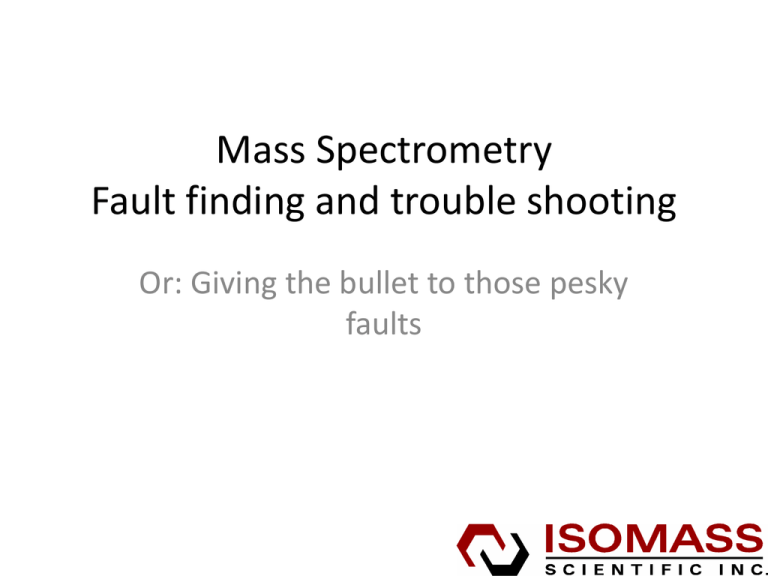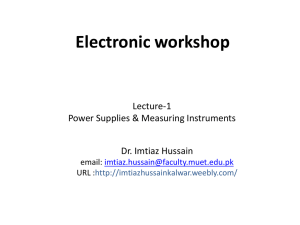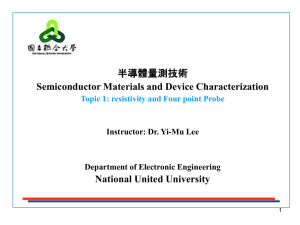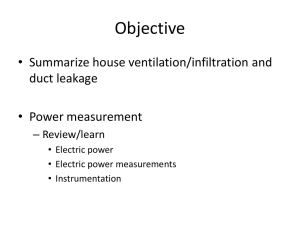"Shoot from the hip" Electronic trouble
advertisement

Mass Spectrometry Fault finding and trouble shooting Or: Giving the bullet to those pesky faults Disclaimer Mass spectrometers can cause pain Hot soldering irons can burn 3000 volts can kill 230 Volts can kill Please beware that any work on the instrument is carried out at your own risk. Isomass Scientific cannot be held responsible for injury or damage caused by following these techniques. Protect your eyes Mental pain! Salesman’s view of solving instrument problems New! Reality • Budget shortfalls – Not enough money to buy a new instrument – Not enough money to pay for service What to do • Learn how to look after your own instrument – Go on the manufactures training courses – Ask questions during the installation and any visit made by an engineer – Regularly attend ASITA – Read the manual and other books – Take an electronics course Fault Finding • Use the instrument supplier as a resource – The engineers are trained on the instrument – The engineers want to help – The engineers will have access to more information • Take your time – Fault finding is not a race – More intervention usually leads to more damage – Take notes and pictures Fault Finding • Beware of dangerous voltages that might be present in the unit under investigation – The 230 volt supply into most units can be fatal if touched – Source supplies are usually at high voltage, > 3kv • Be careful when connecting or disconnecting meter probes – A badly placed probe can cause a short and further damage • Double check connections and meter setting before turning on the unit under test Fault Finding • Check power supplies first – Fuses, check with a meter on resistance not just visually – If a supply voltage is less than expected it could be that the supply is damaged or the load is pulling the supply voltage down – Regulated supplies should have very low a.c. ripple – All electronics can be seen as either a supply or load Fault Finding Think before acting #1 5 minutes thought can save hours of work Fault Finding Think before acting #2 Think about the problem before acting Art is a science • Learn to draw – Draw a block diagram of the fault area – Write down the inputs and outputs of each block – Make a list of possible causes My block diagram Power Block Diagram A few simple techniques • Swap – Exchange the suspected part • Measure – Compared the measured parameter with the expected value • Observe – Look to see what’s happening • Write – Keep good notes Swap Pirani reads atmosphere Pirani reads 1e-3mbar Simplify Use a blank at point 'A' to test the sub- system within the instrument as a whole Pirani showing atmosphere after 10 minutes pumping Voltage Measurement Voltage Measurement • Multimeter set to a.c. or d.c. voltage as required – Black lead in common socket – Red lead in V socket • Voltage measured across one component measures across all components in parallel – Voltage is measured in parallel – Circuit is powered • Connect red probe to one lead of the component and the black probe to the second lead – If meter is auto-ranging note the displayed multiplier Current Measurement Current Measurement • Multimeter set to a.c. or d.c. current as required – Black lead in common socket – Red lead in mA or A socket as required, if in doubt start in A socket • Multimeter must be in series with the component – If necessary unsolder one lead from the board – Circuit is powered • Connect red probe to the lead of the component and the black probe to the point the lead was previously connected to – If meter is auto-ranging note the displayed multiplier • Often easier to measure voltage across a resister and use V=IR Resistance Measurement Resistance Measurement • Multimeter set to resistance – Black lead in common socket – Red lead in Ω socket • Component must be measured in isolation – Circuit is not powered – If necessary unsolder one lead from the board • Connect red probe to one lead of the resistor and the black probe to the other lead – If meter is auto-ranging note the displayed multiplier Start with the obvious If a light does not work.... Check the light bulb before dismantling the light switch, changing the fuse in the basement etc. Start with the obvious If two light bulbs do not work.... Two bulbs might have blown but it's more likely that there is a fault common to both e.g. the fuse in the basement Fault Finding Take good, clear notes when the instrument is working correctly and notes during any fault finding procedure Don't forget, "RTFM" ! Power Control 230 Volts Control Relay Switched outlet Vacuum control Vacuum parts Vacuum Start-up Quick Rotary Pump Test Penning Gauge Turbo Pump Faults Vacuum Service • Rotary pump – Change the pump oil every 6 months • Turbo pump – Change the oil wicks yearly Ion Source Control Ion Source Electronics ~4.2A 1.5mA ~4A ~800µA ~700µA Ion source Exploded Ion Source Source Cleaning Magnet Supply Magnet Screwdriver Test Inlets Dual Inlet Valve Control GC Combustion EA GasBench GasBench #140, 5700 – 1 Street S.W., Calgary, Alberta T2H 3A9 isomass@isomass.com Tel: (403) 255-6631 . Fax: (403) 255-6958 Toll Free: 1-800-363-7823











